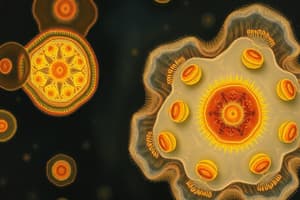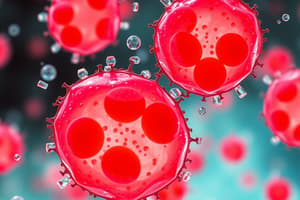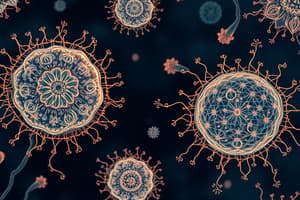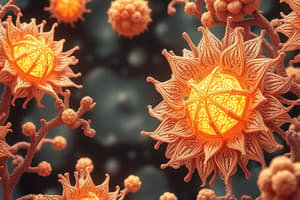Podcast
Questions and Answers
Which of the following characteristics is common to both prokaryotic and eukaryotic cells?
Which of the following characteristics is common to both prokaryotic and eukaryotic cells?
- Ability to perform oxidative phosphorylation
- Presence of a defined nucleus
- Presence of membrane-bound organelles
- Presence of chromosomes with DNA (correct)
Which of the following is a characteristic of archaea?
Which of the following is a characteristic of archaea?
- They obtain energy primarily through photosynthesis.
- They are exclusively found within the human microbiome.
- They only thrive in environments lacking salt.
- Some species live in anaerobic environments and produce methane. (correct)
What distinguishes cell differentiation from cell specialization?
What distinguishes cell differentiation from cell specialization?
- Differentiation refers to a cell's form and type, while specialization refers to its function. (correct)
- Specialization occurs before differentiation in cellular development.
- Differentiation refers to a cell's function, while specialization refers to its form and type.
- Differentiation is a process unique to prokaryotic cells.
How are glucose, fructose, and galactose related chemically?
How are glucose, fructose, and galactose related chemically?
Which characteristic is associated with reducing sugars?
Which characteristic is associated with reducing sugars?
What is the role of fiber in digestion?
What is the role of fiber in digestion?
What type of bond forms between two monosaccharides to create a disaccharide?
What type of bond forms between two monosaccharides to create a disaccharide?
What is the key structural difference between amylose and amylopectin?
What is the key structural difference between amylose and amylopectin?
What role does the cytoskeleton play in cellular trafficking?
What role does the cytoskeleton play in cellular trafficking?
If a protein is synthesized in the RER and is destined to function within a lysosome, what modification must occur in the Golgi apparatus to ensure proper targeting?
If a protein is synthesized in the RER and is destined to function within a lysosome, what modification must occur in the Golgi apparatus to ensure proper targeting?
What is the role of dolichol in protein formation within the RER?
What is the role of dolichol in protein formation within the RER?
What best describes the process of autophagy?
What best describes the process of autophagy?
Which of the following is a key function of the smooth endoplasmic reticulum (REL)?
Which of the following is a key function of the smooth endoplasmic reticulum (REL)?
If a cell's RER is highly active, what organelle would you expect to be abundant?
If a cell's RER is highly active, what organelle would you expect to be abundant?
What is the origin of the clathrin that coats vesicles leaving the trans face of the Golgi apparatus?
What is the origin of the clathrin that coats vesicles leaving the trans face of the Golgi apparatus?
How do early endosomes mature into late endosomes?
How do early endosomes mature into late endosomes?
What is the primary function of the protein transporter located in the lysosomal membrane?
What is the primary function of the protein transporter located in the lysosomal membrane?
What is the role of catalase within peroxisomes?
What is the role of catalase within peroxisomes?
What is a key difference between beta-oxidation in mitochondria and peroxisomes?
What is a key difference between beta-oxidation in mitochondria and peroxisomes?
Where does glycolysis take place in a eukaryotic cell?
Where does glycolysis take place in a eukaryotic cell?
What is the net gain of ATP molecules directly produced during glycolysis per molecule of glucose?
What is the net gain of ATP molecules directly produced during glycolysis per molecule of glucose?
What is the crucial role of ATP in cellular metabolism?
What is the crucial role of ATP in cellular metabolism?
Which enzyme plays a rate-limiting regulatory role in glycolysis?
Which enzyme plays a rate-limiting regulatory role in glycolysis?
During the Krebs cycle, what molecule initially combines with acetyl-CoA?
During the Krebs cycle, what molecule initially combines with acetyl-CoA?
Which of the following is true about mitochondria?
Which of the following is true about mitochondria?
Flashcards
Cell Capacity
Cell Capacity
Ability to grow, reproduce, and specialize.
Two Basic Cell Types
Two Basic Cell Types
Basic cell types differing in size and internal structures; both have chromosomes with DNA.
Prokaryotes
Prokaryotes
Domain including archea and bacteria with genetic material in the nucleoid.
Eukaryotes
Eukaryotes
Signup and view all the flashcards
Carbohydrates (CHO)
Carbohydrates (CHO)
Signup and view all the flashcards
Isomers
Isomers
Signup and view all the flashcards
Reducing Sugars
Reducing Sugars
Signup and view all the flashcards
Disaccharides
Disaccharides
Signup and view all the flashcards
Starch (Almidón)
Starch (Almidón)
Signup and view all the flashcards
Glycogen
Glycogen
Signup and view all the flashcards
Membranous Organelles
Membranous Organelles
Signup and view all the flashcards
Rough Endoplasmic Reticulum (RER)
Rough Endoplasmic Reticulum (RER)
Signup and view all the flashcards
Cisternae (RER)
Cisternae (RER)
Signup and view all the flashcards
RER vs REL Ribosomes
RER vs REL Ribosomes
Signup and view all the flashcards
RER Functionality
RER Functionality
Signup and view all the flashcards
Golgi Apparatus (AG)
Golgi Apparatus (AG)
Signup and view all the flashcards
Golgi Cis Face
Golgi Cis Face
Signup and view all the flashcards
Protein Modification in Golgi
Protein Modification in Golgi
Signup and view all the flashcards
Lysosomes
Lysosomes
Signup and view all the flashcards
Phagosomes
Phagosomes
Signup and view all the flashcards
Peroxisomes
Peroxisomes
Signup and view all the flashcards
Beta-oxidation
Beta-oxidation
Signup and view all the flashcards
Mitocondria
Mitocondria
Signup and view all the flashcards
Glucólisis (Glucolysis)
Glucólisis (Glucolysis)
Signup and view all the flashcards
Anabolism
Anabolism
Signup and view all the flashcards
Study Notes
- Cells can grow, reproduce, and specialize.
- George Grey first cultured human cells and called them Hela cells.
- Two basic cell types exist, differing in size and internal structures (organelles).
- Both cell types have chromosomes with DNA.
Prokaryotes
- Include archaea and bacteria domains.
- Genetic material resides in the nucleoid.
- Located on the skin surface or consume nutrients in the digestive tract.
- There are more prokaryotic cells than eukaryotic.
- Well-known archaea species are classified into four groups
- Methanogens: live in anaerobic environments and obtain energy through methane.
- Halophiles: thrive in high-salt environments.
- Acidophiles: live in acidic environments.
- Thermophiles: develop at high temperatures (46 °C).
- The bacteria domain includes cyanobacteria.
- Microbiota are prokaryotic cells living in bodies.
- Intestinal flora, sweat, and vaginal canal can weigh up to 4 kg.
Eukaryotes
- Include protists, fungi, plants, and animals.
- Evolved from prokaryotes.
- Feature more genetic information.
- DNA relates to proteins.
- Cell differentiation refers to cell shape and type (e.g., a neuron).
- Specialization refers to the cellular function (e.g., neuronal function).
Biological Macromolecules
Carbohydrates
- Carbohydrates contain CHO
- Composed of sugar molecules.
- Most abundant molecules in nature.
- Composed of oxygen, carbon, and hydrogen.
- Commonly consumed carbohydrates include starch, sucrose, lactose, and maltose.
- 99% are plant-based, excluding galactose from milk.
- Simple carbohydrates, like sugar, break down quickly and elevate sugar levels.
- Complex carbohydrates, like whole grains, digest slowly and provide sustained energy.
- Fiber aids in transporting triglyceride molecules.
- Energetic functions involving metabolism serve as an immediate energy source that breaks down into glucose.
- Blood Sugar Regulation: They prevent hypoglycemia by constantly supplying energy to the body.
- Energy is stored in the form of starch.
- Classified based on the number of saccharide units (sugar molecules), like Mono, Di, Oligo, and Poly.
- Monosaccharides include glucose, fructose, galactose, mannose, and ribose.
- Glucose, fructose, and galactose are isomers with the same molecular formula (C6H12O6) but different atomic arrangements.
- Each unit is reducing sugars.
- Have a functional group (aldehyde or ketone) freely available.
- Can reduce copper present in Benedict's reagent.
- Reducing sugars are carbohydrates with a free ketone or aldehyde group.
Disaccharides
- Consist of two monosaccharides
- A glycosidic bond (covalent bond) joins two carbohydrates between the hydroxyl (OH) groups of both monosaccharides, leading to the loss of a water molecule.
- Sucrose: Glucose + Fructose
- Maltose: Glucose + Glucose
- Lactose: Glucose + Galactose
Oligosaccharides
- These consist of 3 to 10 monosaccharides
- Produced during digestion by starch exchange
- Isomaltoriose
- Dextrin
- Maltodextrin.
Polysaccharides
- These have more than 10 monosaccharides.
Starch:
- Starch is a homopolysaccharide and serves as the carbohydrate reserve of plants
- Consists of two subunits
- Amylopectin is formed only by glucose units through alpha-1,4 glycosidic linkages and alpha-1,6 linkages in its branches. It contains more sugar molecules and has branches.
- Amylose: Formed solely by glucose units with alpha-1,4 glycosidic linkages without branches.
Glycogen
- This is a homopolysaccharide branched by millions of glucose molecules.
- Synthesized and stored in the liver and skeletal muscle.
- It stores sugar.
Cellulose
- This is a homopolysaccharide formed by glucose units but with a beta-1,4 linkage.
- Digestive enzymes cannot recognize it, so it remains in the intestine, trapping water to form fecal matter as fiber.
- Cellobiose is the disaccharide derived from cellulose.
Membranous Organelles
- Membrane-bound organelles include the Rough Endoplasmic Reticulum (RER), Smooth Endoplasmic Reticulum (REL), Golgi apparatus, endosomes, lysosomes, and peroxisomes.
- Intracellular traffic refers to molecule movement entering or forming within the cell, passing through different "stations."
- Organelle movement and exchange rely on the cytoskeleton
- The cytoskeleton forms tension-based structures similar to "roads," enabling organelle mobility within the cell without collisions.
Rough Endoplasmic Reticulum (RER)
- The RER is an intracellular membranous system extending from the nuclear plasma membrane
- The RER emerges from the nucleus's outer membrane, situating it near the nucleus.
- The endoplasmic reticulum defines the luminal/cisternal and cytosolic spaces.
- The nucleus is surrounded by an outer membrane, giving rise to the RER, which features ribosomes on its surface.
- Proteins made in the RER are destined to leave the cell or become part of its membrane.
- Glycoproteins are also synthesized in the RER.
- Cytosol refers to everything inside the cell, excluding the nucleus.
- The rough endoplasmic reticulum is continuous with the smooth endoplasmic reticulum, but the latter lacks ribosomes on its surface.
RER Functions:
- Protein, lipid, and steroid hormone formation.
- Intracellular molecule transportation.
- Found exclusively in eukaryotic cells.
Reticulum Composition:
- 30% lipids
- 70% proteins
- Less than 1% carbohydrates.
- Spaces between RER sacs are called cisternae.
- In the REL, these spaces are called cavities.
RER vs REL Differences:
- The primary structural difference lies in the presence or absence of ribosomes.
- The RER has ribosomes on its surface, whereas the REL does not.
Functionality:
- The RER is involved in protein production.
- The REL performs functions unrelated to protein synthesis.
- Requires electron microscopes for observation; it cannot be seen with an optical microscope.
- The lumen is the space between flattened RER sacs where ribosomes cannot be seen.
- The lumen's thickness depends on the activity of that organelle in the specific cell.
- Pancreatic cells are representative of the RER.
- Cells can have varying organelle quantities.
- Ribosomes consist of two subunits and are responsible for generating the translation of the genetic code into an amino acid.
- Production is high in cells with an abundance of endoplasmic reticulum.
Molecule Formation in the RER
- Everything exiting the RER is enveloped in a vesicle and directed toward the Golgi apparatus for packaging.
- As the molecule leaves the RER, the RER membrane undergoes evagination. In the Golgi apparatus, invagination occurs, and this vesicle becomes part of the Golgi's cellular membrane
- The content remains within the Golgi apparatus.
- Functions as protein synthesis and storage.
- Proteins functioning within the cell are formed in free ribosomes located in the cell's cytosol.
- Some proteins exit the cell, while others remain part of the cellular membrane as transmembrane proteins.
- Glucosylation of proteins occurs when all proteins formed in the RER are glycoproteins, remaining in the lumen and awaiting direction to their destination for function.
- The dolichol molecule, hydrophobic, aids oligosaccharide attachment to the protein
- It grabs the oligosaccharide and transports it to the RER lumen for association, forming a glycoprotein.
- Misfolded polypeptide recognition: the cell manufactures proteins, and everyone carries defective genes.
- Cells correct themselves or discard and result in rare diseases
- Proteins that do not form correctly are degraded by the RER.
ER-Associated Degradation (ERAD)
- Before a protein exits to the Golgi apparatus, the reticulum halts and eliminates it.
- These proteins are known as proteasomes, which function within the cell
- This suggests they form within free ribosomes of the cytosol.
- Failure of proteasomes to stop misformed proteins may cause cystic fibrosis.
- Glycoprotein formation occurs when an oligosaccharide links to a protein.
- N-glycoproteins form when the oligosaccharide binds to the amino group of proteins, specifically the amino acids asparagine or glutamine, which have an acidic pH.
- O-glycoproteins bind to the hydroxyl group of threonine and serine.
- Ribosomes consist of major and minor subunits.
- Messenger and transfer RNA reach the ribosome, grouping in triplets of nucleotides.
- Proteins that act within the cell do not undergo glycosylation.
Smooth Endoplasmic Reticulum (REL)
- REL performs various functions like detoxifying drugs, metabolizing carbohydrates, storing calcium, and forming lipids and sterols, such as steroid hormones.
- REL helps hormonal production.
- Organs with a high REL content include the liver, lungs, ovaries, and testicles.
- Molecules are first oxidized, dehydrated through hydrolysis, isomerized, and then the reaction known as glycosylation occurs.
- Glucose forms as glycogen in the liver during dephosphorylation.
- Glycogen degradation produces glucose 6-phosphate, and the enzyme glucose 6-phosphatase removes the phosphate for glucose to exit
- Certain proteins capture calcium, bringing it into the RER lumen for calcium reserve. It is released during contraction.
Diseases associated with the REL
- Liver impairments like cirrhosis can stem from compromised REL function in the liver.
- Conditions linked to calcium scarcity in the REL, like specific muscular dysfunctions.
Golgi Apparatus (AG)
- The Golgi apparatus consists of cisternae (dictyosomes) but, unlike the RER, lacks ribosomes on its external membrane.
- Golgi sacs/cisternae are not anastomosed, meaning they are not linked by continuous membranes.
- Everything leaving the RER enters the Golgi apparatus.
- The Golgi apparatus has two faces
- cis face is oriented toward the RER and nucleus, receiving vesicles from the RER.
- trans face faces the cellular membrane
- It forms vesicles that transport proteins and lipids.
- Proteins made in the RER that need transport or secretion are modified in the Golgi adding phosphate groups and tagged for final destinations (like lysosomes or cellular membranes).
Golgi Apparatus Functions:
- Protein synthesis and storage.
- Protein phosphorylation and glycosylation.
- Formation of secretory vesicles and lysosomes.
- Vesicles exit by evagination and enter the Golgi Apparatus through membrane invagination.
- Over 90% of proteins made in the RER are destined for a differing cell or the cellular membrane.
- As faces on Golgi ends are known.
- The cis face, known for formation, faces the RER and nucleus, while the trans face is at the other end
- Intermediate cisternae are in the middle of the two faces.
- Cisternae are also identified with names.
- Certain enzymes that phosphorylate, dephosphorylate, or glycosylate in the middle faces/cisternae are maintained.
- The cis face, close to the RER, accepts and distributes vesicles coming from the RER.
- Glycoproteins are phosphorylated and joined with phosphate groups.
- Some proteins exiting the RER can accept a phosphate in carbon 6, gaining the name mannose-6-phosphate and indicating their final destination to the specific enzyme which will conver it into a lysosomal enzyme.
- Every protein produced in the RER is translated, referring to primary formation deriving from RNA.
- Glycosylations that contrast phosphorylation exist.
- Polysaccharides known as glucosaminoglycans also form.
- These make up the extracellular matrix.
- Certain protein types operate in every organelle.
- Proteins produced in RER, required for a specific organelle are directly trasnported to the intermediate cisternae and transported back in the RER/REL.
- The trans face forms secretory vesicles and lysosomes, tagged with mannose-6-phosphate.
- The cell must have Golgi bodies wherever there is RER. Otherwise, the proteins are not fully packed and cannot be transported.
- Pancreas, will follow the functions of the AG and everything that exits the RER is passed to the Golgi apparatus to produce digestive enzymes
Vesicles
- Vesicles exiting the Golgi have two coatings: clathrin and coprotein.
- Clathrins surround vesicles exiting, then release, forming lysosomes without clathrin.
- The vesicles secrete in three distinct ways
- Constitutive pathways are constant processes involving vesicles surrounded by COP I.
- Facultative/controlled pathways secrete enzymes upon certain stimuli, supplied by molecules known as ligands that may be hormones/neurotransmitters from bloodstream attaching to cell membrane.
- These signals trigger vesicle opening, liberating the contained protein where vesicles possess clathrin.
- Protein types within COP I proteins include collagen, integral membrane proteins, and growth-related factors like fibroblasts.
Facultative Secretion
- Proteins, along with lysosomes, include zymogens (inactive enzymes) and pepsinogen.
- When the vesicle clears, pepsinogen exits a pancreatic cell through a bloodstream.
- Once exposed to HCl in the stomach, it activates to transform into pepsin.
Endosomes
-
Endosomes form through endocytosis, where the cell engulfs external particles.
-
Early endosomes possess a pH of around 6, positioning them near cell membranes.
-
Late endosomes, with a more acidic pH (around 5.5), mature to advance within the cell for merging with lysosomes.
-
Aim of endosomes is to convey and process internal cell material, whether for collapse or re-consumption.
-
The cell forms a clathrin-coated vesicle to internalize nutrients or external particles. This vesicle transitions into an endosome before becoming a lysosome.
-
The pH of late endosomes is acidic
-
Excretory vesicles at pH 5.5 produce digestive enzymes (hydrolases).
-
An ATPase pump maintains pH within the vesicle, introducing protons.
-
The more protons, the more acidic. Early endosomes lack this proton pump.
-
The routes are specific to the early endosome.
-
Early endosomes can target late endosomes, activating lysosomes upon merging and participating in transcytosis.
-
Transcytosis occurs when a molecule travels across a cell.
-
Paracellular transport involves molecules only traversing a portion, all achieved via invagination
-
Early endosomes act as a "sleeping" lysosome, maturing as they approach the cell center.
Lysosomes
- Lysosomes are tasked with cellular digestion and breakdown.
- Lysosome's hydrolytic enzymes break down cellular & extracellular matter.
- Lysosomes possess an internal protein transporter in membrane to remove monomers (breakdown products) of proteins & carbohydrates, such as amino acids & monosaccharides.
- If lysosomal enzymes fail, rare conditions arise like Pompe disease.
- An enzyme not degrading properly caused by defective protein can cause rare diseases like Pompe disease.
- Direct contact of lysosomal enzymes must be avoided with the cytosol to avoid autolysis, destruction stemming from enzymes, which results in uncontrolled cell death.
- Phagosomes (fago: eat): are vesicles via two immune system cell actions which create a vesicle used to eat bacteria.
- Autophagosomes form through cell self digestion, as with apoptosis except for non-programmed autophagy.
- If the contents entering lysosomes do not degrade fully, then are termed residual bodies such as lipids).
- Purely residual lipids are called myelin bodies.
Peroxisomes
- Has multiple enzymes with lower quantities versus lysosomes and operates as minute furrows.
- It specializes in detoxification, specifically in hepatocytes, neutrophils along with renal cells.
- They self-replicate, increasing by division.
- Peroxisome enzymes have catalases, peroxidase/alcohol dehydrogenase, which allows ethanol detoxification by beta-oxidation processes.
- Catalase degrades hydrogen peroxide into compounds similar to water including carbon dioxide.
- Alcohol dehydrogenase breaks down the ethanol and is used when there are excessive occurrences that lead to drunkenness.
- Lower concentration of free radicals helps neutrophils ward off/prevent infections.
- Beta-oxidation refers to when lipids "burn" as fat oxidization and source energy.
- Beta-oxidation is most seen in mitochondrias.
- Peroxisomal beta-oxidation minimizes large groups of fatty acids by groups containing 4-8 carbons.
- These short fatty acids travel down to mitochondria as energy, where function shortens the fatty acid chain.
- Energy creation involves the process known as the electron transport chain.
- However, the process do not occur in terms of peroxisomes, and thus, no energy production.
Autolysis vs. Apoptosis
- Autolysis refers to a cellular process of self-destruction from internal anomalies; apoptosis is cellular death from a homeostatic mechanism for balance/growth.
Cellular Respiration
Glycolysis
- Occurs outside the mitochondria in the cytosol-cytoplasm.
- Involves breaking apart a sugar molecule during 1st step or glucolysis aka gluco=sugar, lisis=break
- Oligosaccharides originate from digestion processes.
- Cellulose goes straight to intestines.
- Polysaccarides are fibrous, cellulose-heavy/starch-heavy tubercules.
- Matabolism equals Change.
- Glucose intends to exit the cell, which is the point for the glycolysis process.
- Phosphorus allows glucose exit following final-based product, ATP.
Final products
• CO2 • H20 • 2C3–Pyruvate-Pyruvic Acid.
-
There are a total of 36/38 molecules pertaining from ATP with the cellular respiration that can be added to glycolysis.
-
Metabolism and enzymes are heavily tied and forever involved in a metabolistic cycle.
-
Anabolism is associated with combining metabolic processes via simpler molecule synthesis into more complex structures needing energy from ATP, building proteins/lipids.
-
Catabolism happens to be metabolic processes causing simplification of more complex molecules, liberating energy for the utilization to give cellular utility, such as contractile capabilities and also producing ATP through the usage with degradation of the sugar to get fuel.
-
Anabolistics, signalling the top, catalyze structures as exergonics. They are in charge of cellular building plus growth.
-
Catabolistics which lowers the structural quality, such resulting exergonics causes libration for power from the anabolic reactions.
-
Guanosine Triphosphate (GTP)
-
Adenosine Triphosphate (ATP)
-
Hexokinase is the one to add phosphourous to glucose.
-
Removing Tri-bond involves hydrolyzation.
-
3 D-deficient results in illness
-
Dermatitis
-
Dementia
-
Diarrhea
-
Scurvey occurs due to a lack of a Vitamin C
-
Oxidation causes energy gain.
-
Glycolysis applies in fermentation and oxidation.
-
Ten steps for tens reactions, enzyme-based or molecules from all production
-
Net ATP is 4 by which two can be netted, coupled via a pair for molecules pertaining from pyruvate.
-
Phosphofructokinase/-quinase specializes in glycolysis.
-
Oxidization and removing bonds in carb, resulting to CO2 release causes there to be an opening from presence associated through adequate oxygen to result via oxidation via purivate to associate from adequate oxygen with energy for ATP.
Krebs Cycle
- (Tricarboxylic/Citric Acids)
- It acts as essential pathway towards electron transport.
- Produces elevated CO2 levels post-metabolism.
- Functions through essential reduced enzyme pool, for instance: NADH plus FADH.
- Protein's key is synthesis.
- They are utilized when extremities occur for emergencies.
- Acetly - enzyme A specializes at cycles which derive Krebs.
- Transports enzymes along with 32 to 34 energy molecules.
- Sequential process with Kerbs follows:
- Enzyme A is associated toward oxyacetal through citrate emergence.
- Through isocitrate.
- With oxygen to extract oxide bond during alphaketoglutarate synthesis.
- alpha-ktoglutarate becomes oxides, which liberates oxide while generating succinyl-KoA.
- Succinly-KoA transofrms regarding being succinct.
- Succintant is oxidized followed by formation pertaining feumaro.
- Feumaros are now malatos. 8 Followed through oxidation plus production while being called oxaloacetate.
Outcomes via one cycle through Krebs involves:
• 1 Energy molecule (ATP) • 3 Enzyme called NADH • A FADH enzyme • 2 CO2 for oxygen
De - 20 amino has 3 enter via circle or Krebs. • Ailenina - Purivas • Is aspartate - or oxaloacetate. • Glutamato a- Ketaglutaras.
Studying That Suits You
Use AI to generate personalized quizzes and flashcards to suit your learning preferences.




